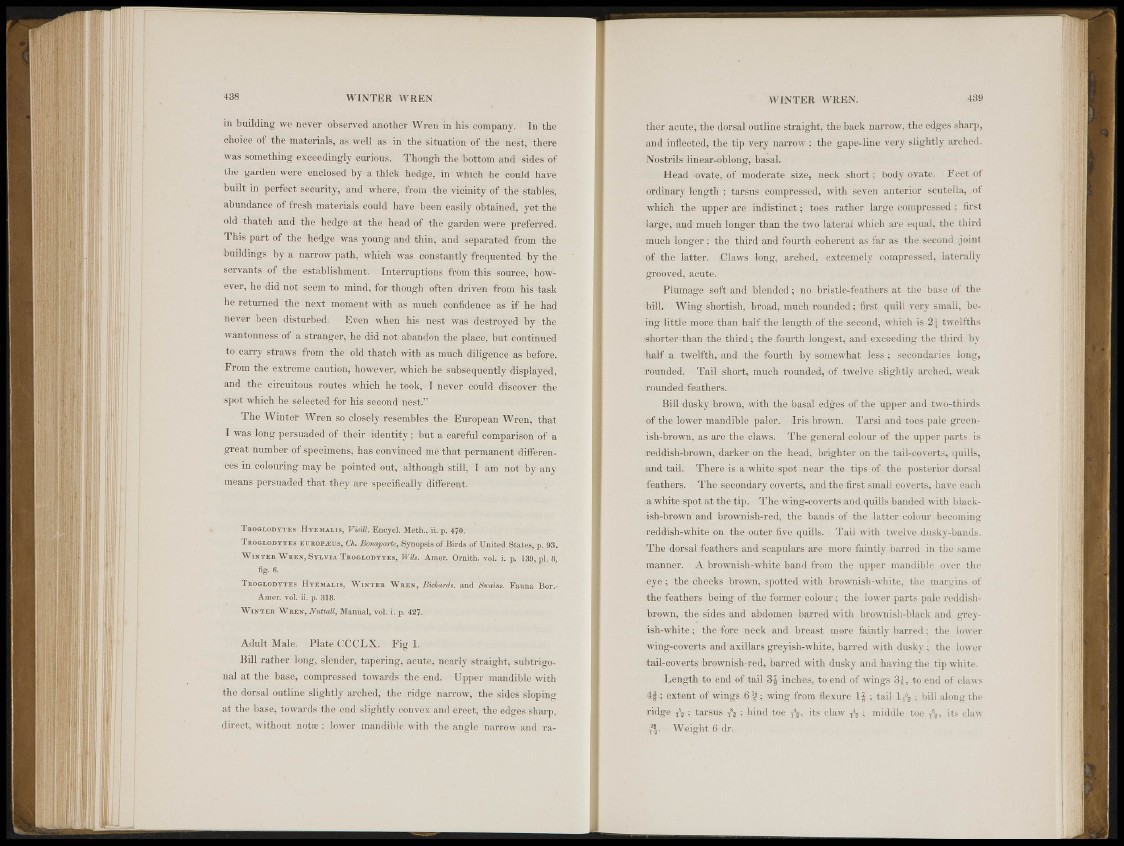
438 WINTER WREN.
in building wo never -observed another Wren in his company. In thè
choree of the materials, as Well as in the situation of the nost, there
was something exeeedingly curious. Tliou«h the :huttom and sides of
the garden were »enclosed by a thick hedge, in whiaMfe could have
built in perfect security, fasd where,- from -the vicinity of the stables,
abundance of ¡'rush materials could have -boeri easily obtained,, yet the
old thatch and the hedge at the head nf the garden were iirelerred.
This part of the hedge was young and thin, and separated from the
buildings by a narrow path, which was constantly frequented by the
•servants of the establishment. Interruptions from this source, however,
he did not seem to mind, for though often driv.iu from li-is task
he returned the -next moment with as much confidence a* if he had
never been disturbed. Ki'ilii when Ms nèsl was destroyed by the
nantmluess of a stranger, he did not abandon the place, but continued
t0 carry straws from the old thatch with as much diligence as before.
From the extreme caution, however, which he subsequently displayed,
and the circuitous routes which ho took. 1 never could d-feeovcir the
sp'ot which hi! selected for his second nest."
The Winter Wren so rolosety resembles the European Wren, that
I was long persuaded of their identity ;; but a careful comparison of a
great number of specimens, has corivmcod mo that permanent differences
in Colouring may te pointed out, although still, • I am rib't by any
means persuaded that they aie« specifically duTerimt. •
"J'HO<i|,!)1>Vl'KS .Hyemalis, VifHi. Kiieyoi. Metli.;' ii. p. 470.
Troglodytes eub.op.eus, Ch. Bonaparte,. Synopsis of Birds of United States, p. 93.
Wi n t e r Wren, Sylvia Troglodytes, Wtts. Amer. Ornitk. vol. i. p. 139, pi. 81-.
.% 6.
Troglodytes Hyemalis, Wi n t e r Wren, JRiohards. and Swains. Fauna Bor.-
Amer. vol ii. p. 318.
Wi n t e r Wren, NuttaM, Manual, vol. i. p. 427.
Adult Male. Plate GCCLX. Fig 1.
Bill rather long, slender, tapering, acute, nearly straight, subtrigonal
at the base, compressed towards the end. Upper mandible with
the dorsal outline slightly arched, the ridge narrow, the sides sloping
at the base, towards the end slightly convex and erect, the edges sharp,
direct, without nota?; lower mandible with the angle narrow and ra-
W INTER WREN. 439
ther acute, the dorsal outline straight, the back narrow, the edges sharp,
and inflected, the tip very narrow ; the gape-line very slightly arched.
Nostrils linear-oblong, basal.
Head -ovate, of moderate size, neck short ; body ovate. Feet of
ordinary length ; tarsus compressed, with seven anterior scutella, of
which the upper are indistinct.; toes, rather large compressed ; first
large, and much longer than the two lateral which are equal, the third
much longer ; the third and fourth coherent as far as the second joint
of the latter. Claws long, arched, extremely compressed, laterally
grooved, acute.
Plumage soft and blended ; no bristle-feathers at the base of the
bill. Wing shortish, broad, much rounded ; first quill very small, being
little more than half the length of the second, which is 2\ twelfths
shorter ¡than the third ; the fourth longest, and exceeding the third by
half a twelfth, and the fourth by somewhat less ; secondaries long,
rounded. Tail short, much rounded, of twelve slightly arched,, weak
¡rounded feathers.
Bill dusky brown, with the basal edges of the upper and two-thirds
of the lower mandible paler. Iris brown. Tarsi and toes pale greenish
brown, as are the claws. The general colour of the upper parts is
•reddish-brown, darker on the head, brighter On the tail-coverts, quills,
and tail. There is a white spot near the tips of the posterior dorsal
feathers. The -secondary coverts, and the first small coverts, have each
a white spot at the tip. The wing-coverts and quills banded with blackish
brown and brownish-red, the bands of the latter colour becoming
reddish^white on the outer five quills. Tail with twelve dusky-bands.
The dorsal feathers and scapulars are more faintly barred in the same
manner. A brownish-white band from the upper mandible over the
•eye ; the cheeks brown, spotted with brownish-white, the margins of
the feathers being of the former colour ; the lower .parts pale reddishbrown,
the sides and abdomen barred with brownish-black and greyish
white; the fore neck and breast more faintly barred ; the lower
wing-rcoverts and axillars greyish-white, barred with dusky ; the lower
tail-coverts (brownish-red, barred with dusky and having the tip white.
Length to end of tail 3f- inches,, to end of wings 3?, to end of claws
; extent of wings H|§ ; wing from flexure If ; tail ; bill along the
52 ; tarsus ; hind toe A, its claw T
ridge t
4
2 ; middle toe & its claw
l l . Weie-ht 6 dr.